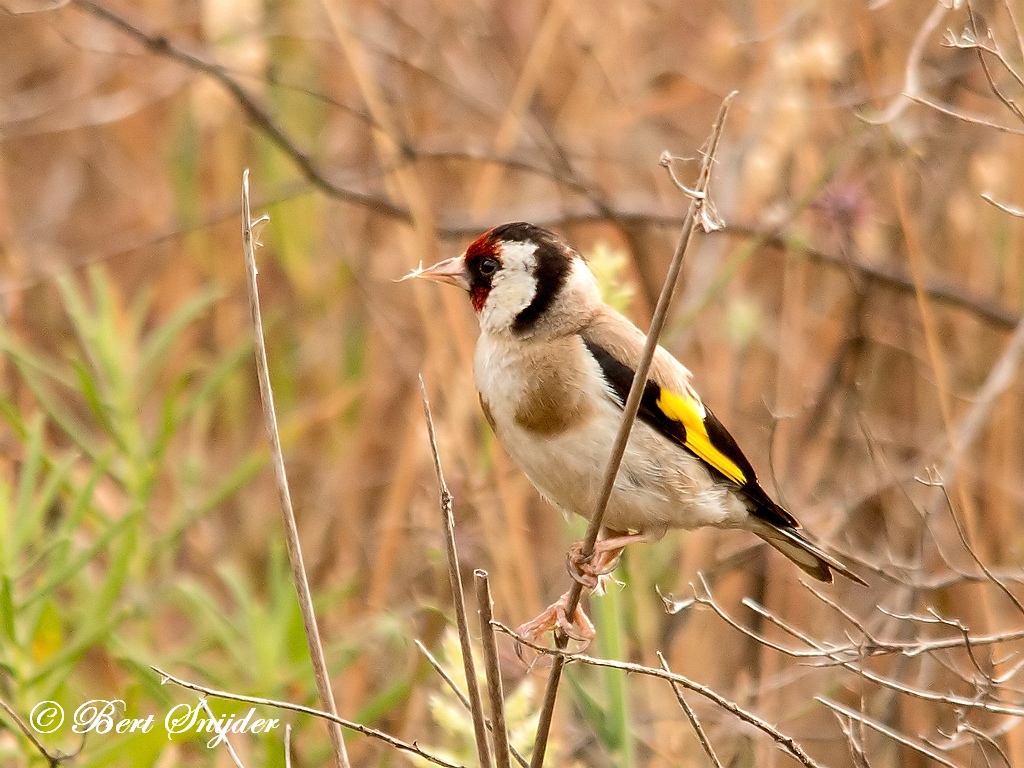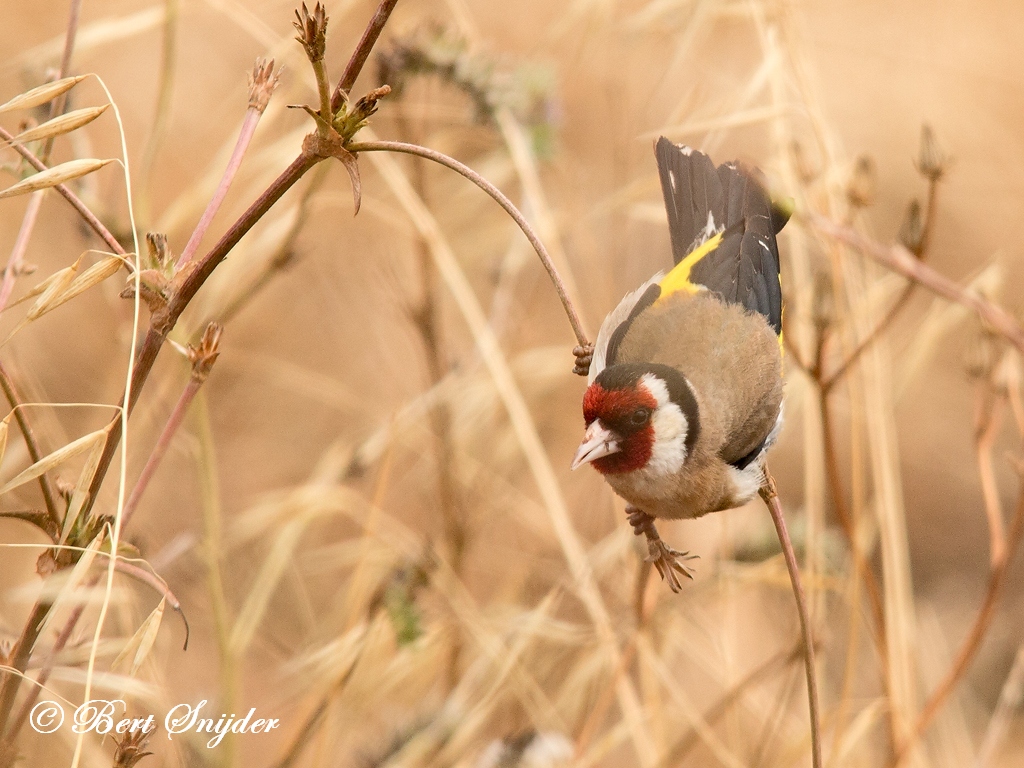European Goldfinch, Putter, Stieglitz, Pintassilgo, Jilguero Europeo
Spotted on Monte Horizonte in the Alentejo region of Portugal. European Goldfinch sound
The Goldfinch or European Goldfinch (Carduelis carduelis) is a small passerine bird in the finch family. It breeds across Europe, North Africa, and western and central Asia, in open, partially wooded lowlands. It is resident in the milder west of its range, but migrates from colder regions. It will also make local movements, even in the west, to escape bad weather. It has been introduced to many areas of the world.

More photos at the bottom of this page:
The average Goldfinch is 12-13 cm long with a wingspan of 21-25 cm and a weight of 14 to 19 grams. The sexes are broadly similar, with a red face, black and white head, warm brown upperparts, white underparts with buff flanks and breast patches, and black and yellow wings. On closer inspection male Goldfinches can often be distinguished by a larger, darker red mask that extends just behind the eye. In females, the red face does not reach the eye. The ivory-coloured bill is long and pointed, and the tail is forked. Goldfinches in breeding condition have a white bill, with a greyish or blackish mark at the tip for the rest of the year. Juveniles have a plain head and a greyer back but are unmistakable due to the yellow wing stripe. Birds in central Asia (caniceps group) have a plain grey head behind the red face, lacking the black and white head pattern of European and western Asian birds.
The species is divided into two major groups, each comprising several races. The two groups intergrade at their boundary, so the caniceps group is not recognised as a distinct species despite its readily distinguishable plumage.
Feeding on thistles – note thistledown in billThe food is small seeds such as thistles (the Latin name is from carduus, thistle) and teasels, but insects are also taken when feeding young. It also regularly visits bird feeders in winter. They nest in the outer twigs of tall leafy trees, or even in bamboo, laying four to six eggs which hatch in 11-14 days.
In the winter they group together to form flocks of up to about 40 birds, occasionally more.
The song is a pleasant silvery twittering. The call is a melodic tickeLIT, and the song is a pleasant tinkling medley of trills and twitters, but always including the trisyllabic call phrase or a teLLIT-teLLIT-teLLIT.
In earlier times, the Goldfinch was kept as a cagebird for its song. Escapes from captivity and deliberate releases have colonised southeastern Australia and New Zealand.
On a birdfeederGoldfinches are attracted to back gardens in Europe and North America by birdfeeders containing niger (commercially described as nyjer) seed. This seed of an annual from South Asia is small, and high in oils. Special polycarbonate feeders with small oval slits at which the Goldfinches feed are sometimes used.




Other synonyms:
Asturian: Xilgueru
Breton: Ar pabor, Kanaber, Kanaper, Pabor
Catalan: Cadernera, Pinsà mec
Catalan (Balears): Cadernera
Valencian: Pinsà mec
Czech: Stehlík obecný
Welsh: Eurbinc, Gwas y Seibi, Jac nico, Jack Nico, Nico, Nicol, Peneuryn, Pobliw, Teiliwr Llundain, Telor Llundain
Danish: Stillids, Stillits
German: Distelfink, Grauköpfiger Distelfink, Stieglitz
Emiliano-romagnolo: Muntana
English: Brittish Goldfinch, Eastern Goldfinch, Eurasian Goldfinch, European Goldfinch, Goldfinch, Gray-crowned Goldfinch, Grey-crowned Goldfinch
Esperanto: kardelo
Spanish: Cardelino, Jilguero, Jilguero Europeo, Verderón
Spanish (Argentine): Cardelino, Jilguero europeo
Spanish (Uruguay): Cardelino
Estonian: Ohakalind
Basque: Cadernera, Karnaba
Finnish: Tikli
Faroese: Fagurígða
French: Chardonneret, Chardonneret élégant
Frisian: Putter
Irish: Gealún fothanán, Glasair choille, Lasair Choille, Lasair coille
Gaelic: Deargan Fraoich, Lasair Choille
Galician: Cadernera, Xílgaro
Manx: Kiark my Leydee, Lossey ny Keylley
Hungarian: Tengelic, Tengelice
Icelandic: Þistilfinka
Italian: Cardellino, Cardellino eurasiatico, Cardellino europeo, Montà
Brescian: Montà
Japanese: goshikihiwa, Goshiki-hiwa
Cornish: Owrdynk
Latin: Carduelis carduelis, Carduelis carduelis carduelis
Limburgish: Keep
Lithuanian: Dagilis
Maltese: Gardell
Dutch: Putter
Norwegian: Stillits
Portuguese: Pintassilgo, pintassilgo-europeu
Portuguese (Brazil): Pintassilgo-europeu
Romansh: Chardelin
Sardinian: Alaldoro, Cadrallìa, Cardulina, Gardanera, Gardeglia, Malasinnora, Manigalinu, Zingrulina
Scots: Lasair choille
Slovenian: lišcek
Albanian: Gardalina, Gardalinë
Swedish: Steglits
Travel Birdwatching Holiday Alentejo, Vacation Portugal for birders to see birds on your trip.